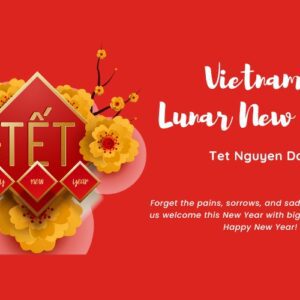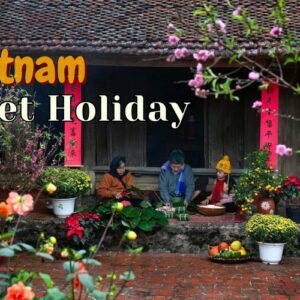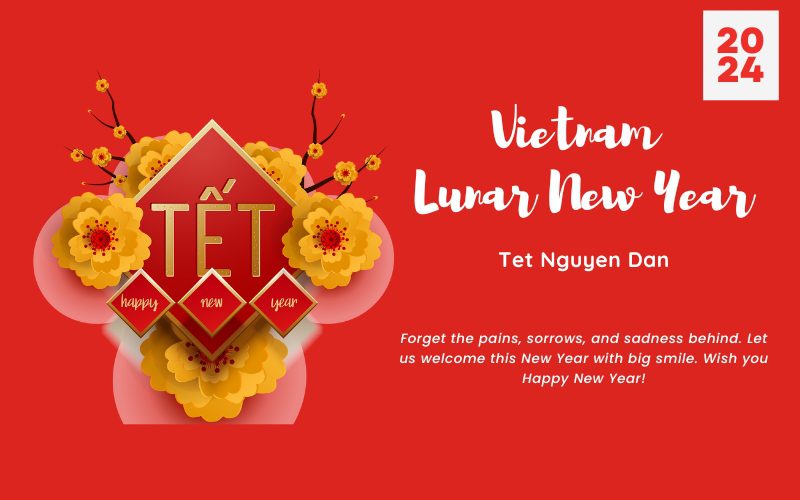
The Vietnamese Lunar New Year, known as Tet or Tet Nguyen Dan, reigns supreme as the most cherished festival in Vietnam. This nationwide celebration marks the dawn of the new year according to the traditional lunar calendar, blanketing the entire country in an atmosphere of joy and festivity. Unlike fixed-date holidays, Tet’s arrival dances with the moon, falling somewhere between mid-January and late February.
Lunar New Year 2024 will dawn on February 10th, marking the arrival of the Year of the Dragon. The following year, 2025, welcomes the Year of the Snake with Tet celebrations beginning on January 29th. And in 2026, the Year of the Horse gallops in on February 17th, marking the start of Tet festivities.
Tet is more than just a calendar date; it’s a vibrant tapestry woven with ancient traditions, family reunions, and vibrant cultural expressions. From the bustling flower markets brimming with colorful blooms to the delicious feasts prepared with love, every aspect of Tet speaks volumes about the Vietnamese spirit of resilience, hope, and togetherness.
The Meanings of Tet
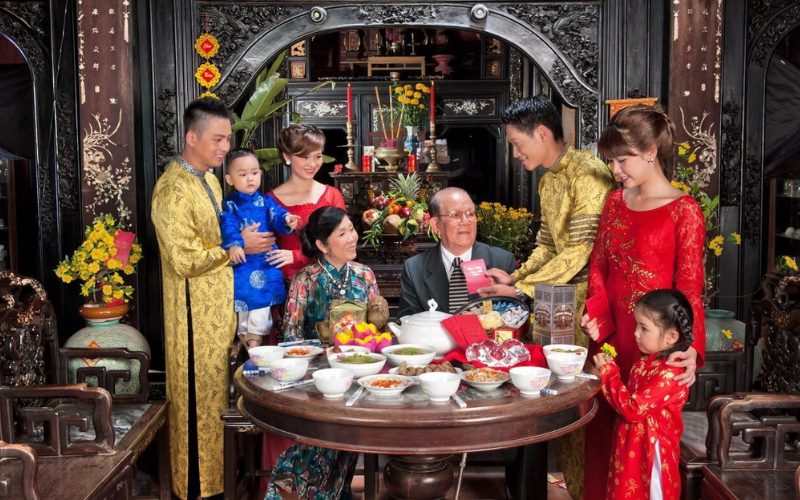
Family reunions at Tet
While the exact origins and complete history of Tet remain a subject of intriguing interpretations, the prevailing belief firmly anchors its roots in the rich soil of Vietnamese heritage. Legends like “Bánh Chưng Bánh Dày” paint a vivid picture of Tet celebrations dating back to the era of the Hung Kings, long before northern occupation. Ancient Chinese texts further corroborate this, describing Tet as a joyous occasion marked by singing, dancing, and feasting.
For the Vietnamese people, Tet holds a profound significance, transcending mere festivity. It embodies deeply spiritual values and fosters strong emotional connections, solidifying its place as a cherished tradition. Far beyond a mere calendar event, Tet signifies the intricate connection between heaven, earth, humanity, and the divine. It is a time for families to reunite, hearts to mend, and spirits to be lifted. As the old year bids farewell and the new one dawns, Tet becomes a sacred space for Vietnamese people to express their heartfelt wishes for good health, abundance, and harmony.
This cherished holiday further serves as a powerful reminder of one’s roots and the enduring value of heritage. It ignites a spirit of reconciliation, fostering harmony and resolving conflicts within communities. In essence, Tet is a testament to the Vietnamese spirit, offering a unique opportunity for renewal, reflection, and the celebration of life itself.
How Vietnamese People Celebrate Lunar New Year
The Vietnamese people, steeped in tradition, meticulously prepare for the revered Tet holiday well in advance. Anticipation for this momentous occasion begins brewing a month, or even one to two weeks, before its arrival. During this time, a vibrant tapestry of special activities unfolds, each meticulously woven to ensure a prosperous start to the new year. From bustling markets overflowing with colorful blooms to homes adorned with festive decorations, the air crackles with anticipation for joy and renewal.
Cleanse and Decorate the Houses
Several days before Tet, Vietnamese families embark on a deeply rooted tradition: a thorough cleansing of their homes. This practice transcends mere tidying; it represents a symbolic purging of the past year’s misfortunes, paving the way for a future brimming with good luck and abundance. Old items are respectfully discarded, making way for the new, while homes are meticulously scrubbed and polished, leaving no trace of the year gone by.
This cleansing ritual is accompanied by the joyous sounds of Tet songs, their melodies filling the air with a sense of anticipation. Vibrant decorations adorn every corner, transforming homes into havens of festivity. Red couplets, imbued with auspicious messages, grace the entranceways, while “cay neu,” a bamboo pole laden with symbolic ornaments, stands as a guardian against evil spirits. The vibrant blooms of Tet flowers, each imbued with special meanings, add bursts of color and fragrance, completing the transformation and creating a warm and welcoming atmosphere.
Shop for New Items & Clothes
This joyous tradition transcends mere consumerism; it’s an outward expression of hope and renewal. Adults, in a delightful ritual, take their children to bustling Tet markets, where new clothes are chosen with wide-eyed wonder and infectious glee. These vibrant garments represent a fresh start, a shedding of the old, and an embrace of the new.
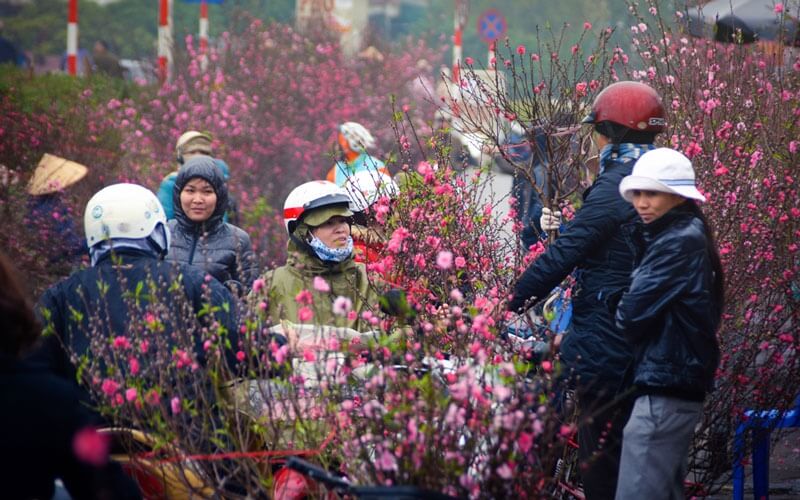
Tet market
At markets overflowing with festive wares, adults meticulously select items to decorate their homes, prepare abundant Tet feasts, and entertain guests with warm hospitality. From fragrant flowers and glistening fruits to traditional preserves and savory delicacies like chicken, sausage, and bamboo shoots, each purchase embodies a deep-rooted connection to cherished traditions.
The exchange of gifts during Tet adds another layer of meaning to this festive season. Each carefully chosen present is a tangible expression of affection, gratitude, and heartfelt wishes for the new year. From elders bestowing lucky money upon children to friends exchanging thoughtful tokens, the act of giving strengthens bonds and fosters a spirit of community and togetherness.
Make Bánh Chưng & Bánh Tét
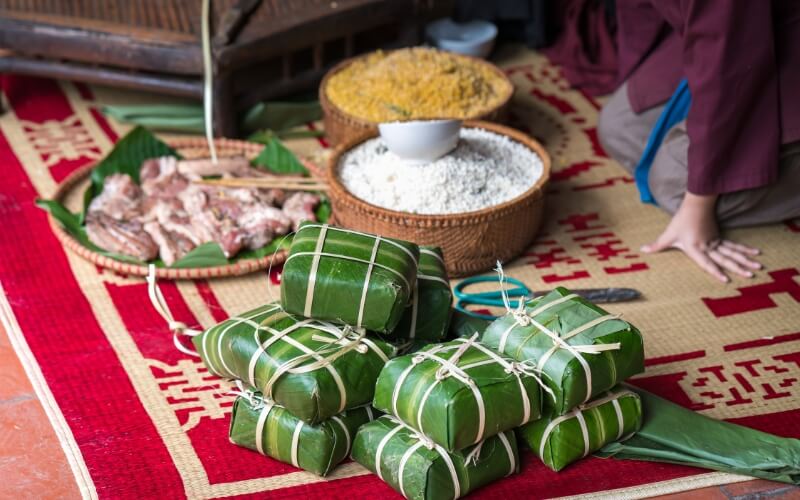
Make banh chung
“Bánh chưng” has been part of Vietnamese culture since the time of King Hung Vuong in the 18th century. Making “bánh chưng” is an opportunity for a family reunion when members share the different tasks of preparing the ingredients for cooking. Bánh Chưng is the symbol of Tet in the North while Bánh Tét (same ingredients, but in a different form) is a specialty of Tet in the south and even in the center.
Ask for Calligraphic Words
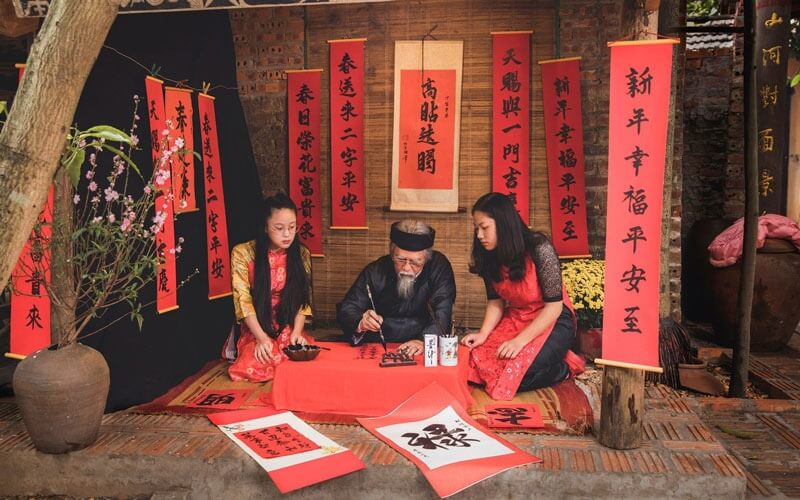
Ask for calligraphic words
During the Tet holiday in Vietnam, local people engage in a beautiful tradition of seeking “Calligraphic Words,” or “Chữ Thư Pháp,” as their wishes for the new year. These words, meticulously hand-written by skilled calligraphers on red paper, carry profound meanings and aspirations for good fortune, health, and prosperity in the coming year.
Popular calligraphic words are “Phúc” (Happiness), “Lộc” (Prosperity), “Thọ” (Longevity), “An Khang Thịnh Vượng” (Peace and Prosperity), and “Vạn Sự Như Ý” (May All Your Wishes Come True). These words are then displayed prominently in homes and businesses, serving as constant reminders of the hopes and dreams for the new year.
Celebrate New Year’s Eve
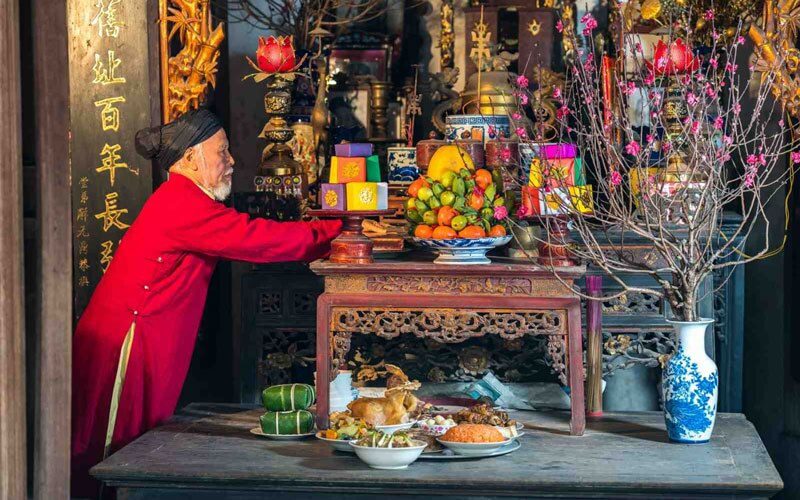
Celebrate New Year’s Eve
New Year’s Eve (Giao Thừa) means the transition from the old to the new year. The Vietnamese people believe that 12 sacred zodiac elements take turns monitoring and controlling the affairs of the Earth. Thus, Giao Thừa is the time when we see the old ruler complete his term and hand over his power to the new ruler.
New Year’s Eve is also the time when Ong Tao (the God of Cooking) returns to the Earth after reporting to the Jade Emperor. Each family organizes an outdoor ceremony to welcome him in their kitchen.
First Guest That Counts
Vietnamese people believe that the first visitor a family receives in the year will determine its fortune for the whole year; so, you should never enter a house on the first day without being invited. The act of being the first person to enter a house on Tet is called “xông đất” or “xông nhà,” which is one of the most important rituals during Tet. According to Vietnamese tradition, if good things happen to the family on the first day of the Lunar New Year, the whole following year will also be full of blessings. Usually, a person of good humor, morality, and success will be the lucky sign of the host family and will be invited into the house first.
Visit Relatives and Friends
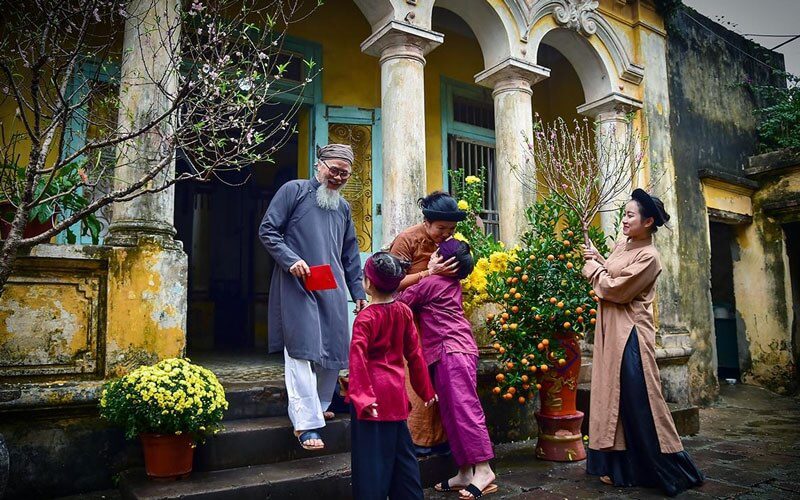
Visit relatives at Tet
Visiting relatives and friends is a cherished tradition that forms the heart of the Vietnamese celebration. Families embark on journeys to visit their grandparents, aunts, uncles, and cousins, often bearing gifts and traditional foods like Bánh Chưng and Bánh Tét. These visits are filled with laughter, heartfelt conversations, and exchanging of blessings for health, happiness, and success in the coming year. Children receive lucky money from elders in red envelopes, symbolizing good fortune and a bright future.
Go to The Pagoda and Temple
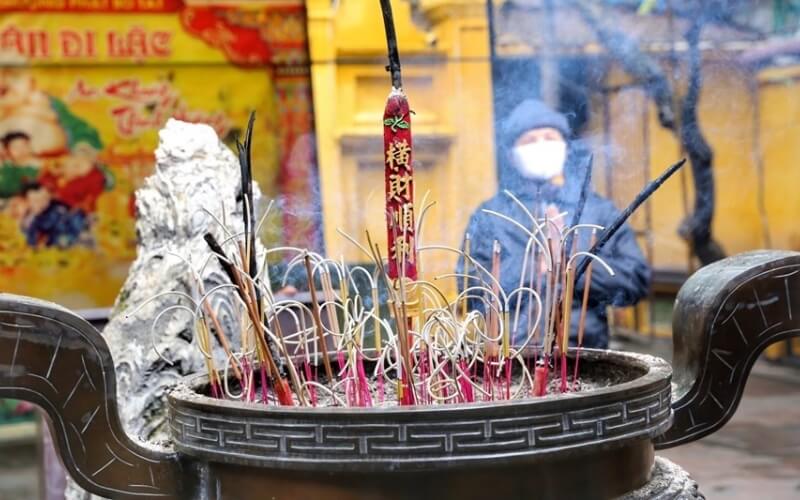
Visit temples and pagodas
During Tet, Vietnamese people often visit pagodas and temples to seek blessings, express gratitude, and strengthen community bonds. The serene atmosphere of these places provides a space for reflection and renewal, and the vibrant decorations and traditional rituals create a unique cultural experience.
People offer incense, flowers, and fruits to deities and ancestors, expressing thankfulness for past blessings and seeking continued protection in the coming year. They pray for peace, health, prosperity, and success for themselves and their loved ones, and the communal atmosphere of these places strengthens bonds between families and friends. This is a time for spiritual renewal, seeking blessings, expressing gratitude, and strengthening community bonds, making it a central element of the Vietnamese Tet celebration.
Traditional Vietnamese Foods at Tet
Tet Food in the North
When discussing Northern Vietnamese food traditions during Tet, the focus often shifts to the meticulously prepared dishes adorning the ancestral altar. These offerings, laden with symbolism and steeped in tradition, form a crucial part of the Tet celebrations.
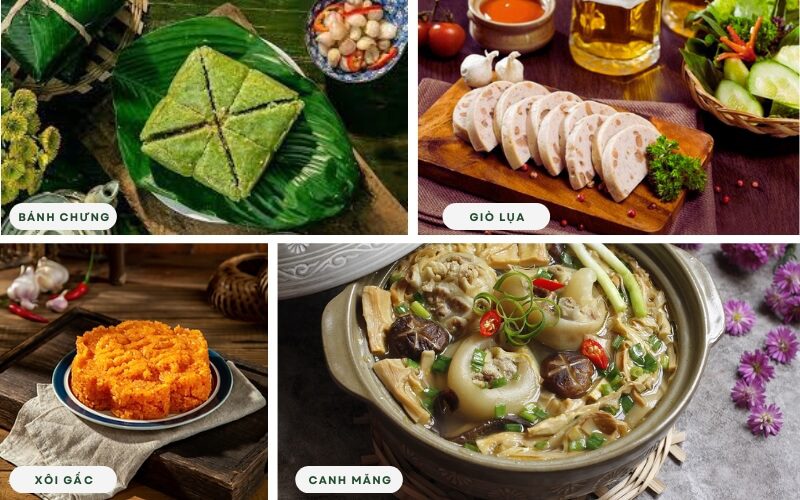
Tet food in the North
- Bánh Chưng – A Square of Earthly Bounty: This iconic square-shaped cake, symbolizing the earth and representing the unity of heaven and earth, is an indispensable element of the Northern Tet feast. Its laborious preparation process, involving glutinous rice, green beans, and fatty pork, embodies the spirit of family togetherness and dedication.
- Xoi Gac – A Red Flush of Fortune: This vibrant red dish, made with sticky rice and the fruit of the gac tree, symbolizes prosperity and good luck. Its presence on the altar signifies wishes for happiness and joy in the new year. The rich red hue not only adds visual appeal but also signifies the warmth and abundance that families hope to receive in the coming year.
- Vietnamese Pork Roll (Giò Lụa) – Harmony and Abundance at the Center Plate: Often occupying the center of the Tet feast, the Vietnamese pork roll (gio lua) represents the core values of family harmony and abundance. Its smooth texture and savory taste, a result of a meticulous preparation process using lean pork and spices, symbolize the desire for a peaceful and prosperous new year.
- Dried Bamboo Shoot Soup (Canh Măng) – Echoes of Tradition: This traditional soup, featuring dried bamboo shoots in a flavorful broth, reflects the culinary heritage of Vietnamese ancestors. Its simple yet comforting flavors evoke a sense of nostalgia and pay homage to the past while celebrating the present.
These dishes, intricately woven into the fabric of Northern Vietnamese Tet traditions, offer more than just sustenance. They are symbolic representations of hopes, aspirations, and gratitude for the past year, marking the start of a new year filled with blessings and joy.
Tet Food in the Central
Central Vietnam boasts a distinct culinary identity, characterized by bold flavors and rich textures. This is especially evident during the Tet holiday in Vietnam when the festive table becomes a showcase of traditional dishes brimming with symbolic significance and delectable tastes.
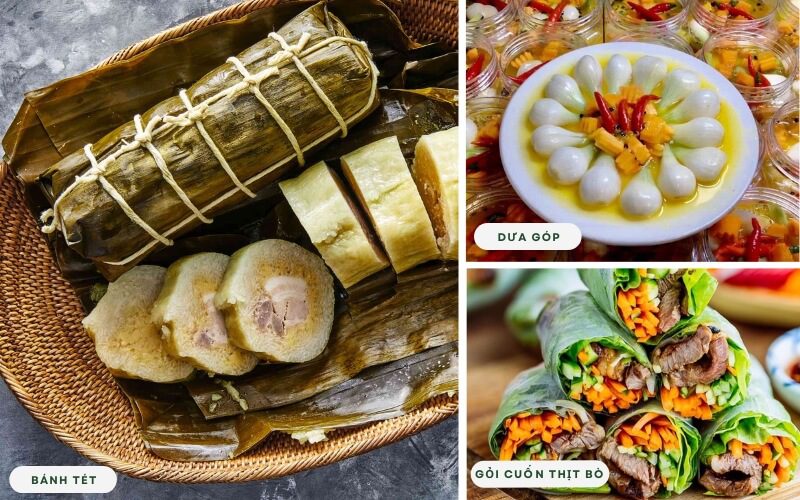
Tet food in the Central
- Bánh Tét – A Round of Completeness: This cylindrical cake, the Central Vietnamese counterpart to the square Bánh Chưng of the North, embodies the concept of fullness and completeness. Its meticulous preparation, involving layers of glutinous rice, savory fillings, and banana leaves, reflects the meticulous attention to detail that defines Central Vietnamese cuisine.
- Pickled Vegetables (Dưa góp) – A Harmony of Sweetness and Sourness: A symphony of sweet, sour, and crunchy flavors, pickled vegetables are an essential accompaniment to Bánh Tét. Carrots, papaya, and other seasonal vegetables are submerged in a tangy brine, creating a refreshing contrast to the richness of the cake.
- Vietnamese Beef Roll (Gỏi cuốn thịt bò) – Festive Hues and Exquisite Tastes: Tet celebrations in Central Vietnam are often adorned with vibrantly colored beef rolls. The tender slivers of beef, marinated in spices and wrapped in glistening rice paper, offer a delightful explosion of textures and flavors. Their delicate red-pink hue adds a touch of festivity to the table, symbolizing good fortune and prosperity in the new year.
Tet Food in the South
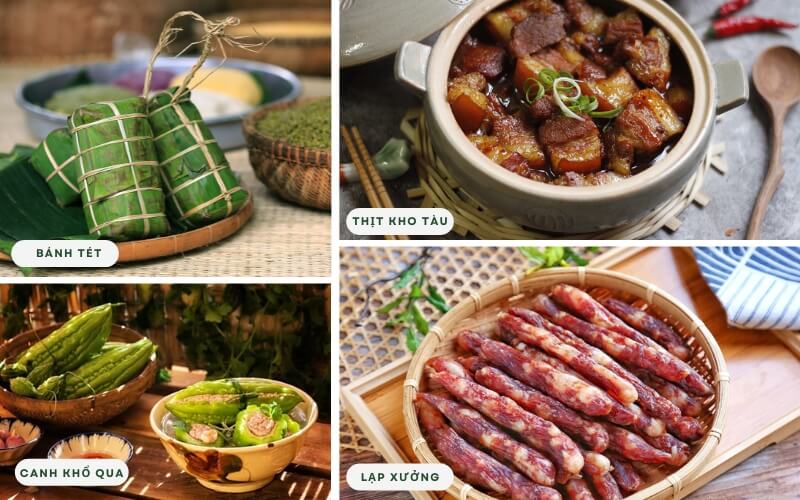
Tet food in the South
People in Southern Vietnam also have their specialties for Tet holiday, such as:
- Bánh Tét – A cornerstone of the Southern Vietnamese Tet celebration, like its counterpart in the Central region
- Braised Pork Belly (Thịt kho tàu) – A symbol of prosperity and togetherness: Simmering in a large pot, the fragrant aroma of Vietnamese braised pork belly fills the air during Tet. The rich flavors and tender meat evoke the warmth and comfort of family gatherings, creating a truly special culinary experience.
- Stuffed Bitter Melon Soup (Canh khổ qua) – A refreshing counterpoint to the richer dishes: Its slightly bitter taste symbolizes overcoming challenges and hardship, while the savory filling and flavorful broth signify welcoming happiness and good fortune in the year ahead.
- Chinese Sausage (Lạp xưởng) – Adding a burst of flavor and aroma: Chinese sausage is a popular Tet dish in Southern Vietnam. Its versatility allows for various preparations, adding a delicious touch to various dishes. From stir-fries to steamed dishes, the distinct taste of Chinese sausage adds a festive element to the Tet culinary landscape.
Where to Feel the Most of the Lunar New Year Festival in Vietnam
Hanoi
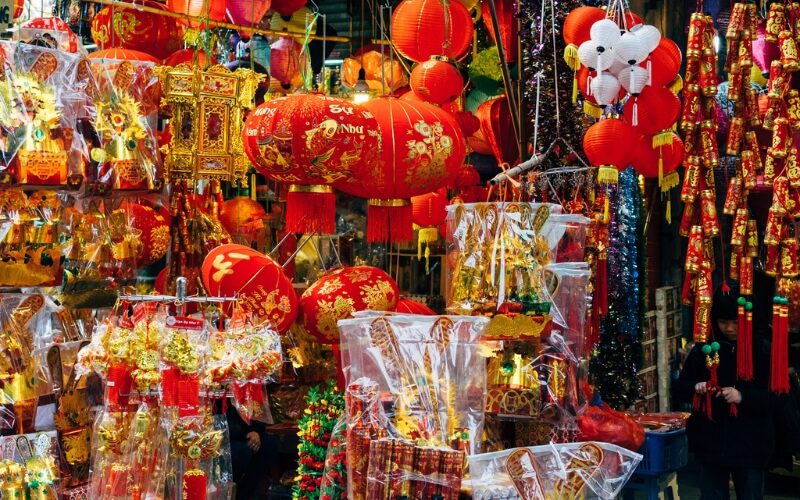
Tet decorations at Hanoi Old Quarter
Hanoi, the capital of Vietnam, offers more options for visitors during the Tet holiday. Although attractions like museums, monuments, and public service centers are closed for the entire week starting on Tet Holiday, travelers can still join in the New Year celebrations by strolling around the Hoan Kiem Lake area.
Some businesses will be closed, but not all. Most luxury hotels are open, and tourism events highlight business. It’s easy to find a few restaurants for dinner. Most grocery stores will be closed, but large shopping centers will be open during the day.
It is advisable to arrive in Hanoi several days before Tet to first visit the attractions and markets, then stay to experience the Lunar New Year. If you are invited to a Vietnamese family, it will be much more fun due to interaction with locals.
Hoi An
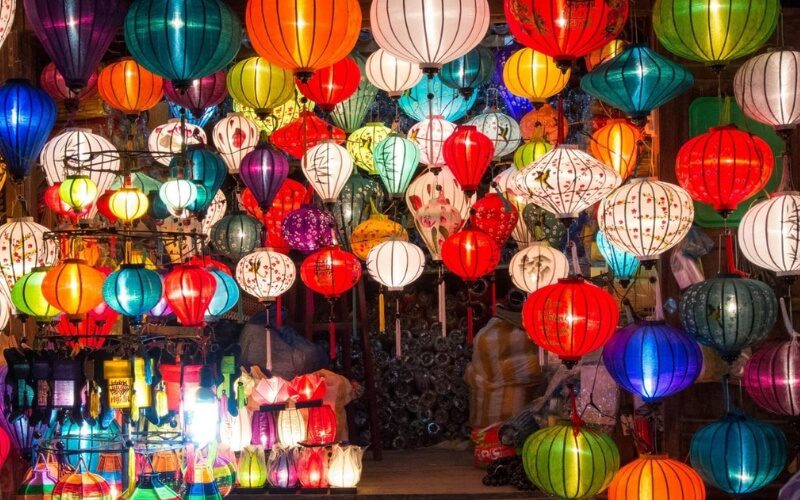
Colorful lanterns during Tet in Hoi An
This charming ancient town in Central Vietnam never ceases to captivate travelers, even the most informed. This 200-year-old city also celebrates the traditional Lunar New Year with several traditional festivals. There is the recitation of Vietnamese poems, the lantern festival, the unicorn dance, and the lottery games. These events attract a large number of participants. Traveling to Hoi An Ancient Town, travelers will experience an excellent atmosphere, totally different from the usual tranquility.
Ho Chi Minh City
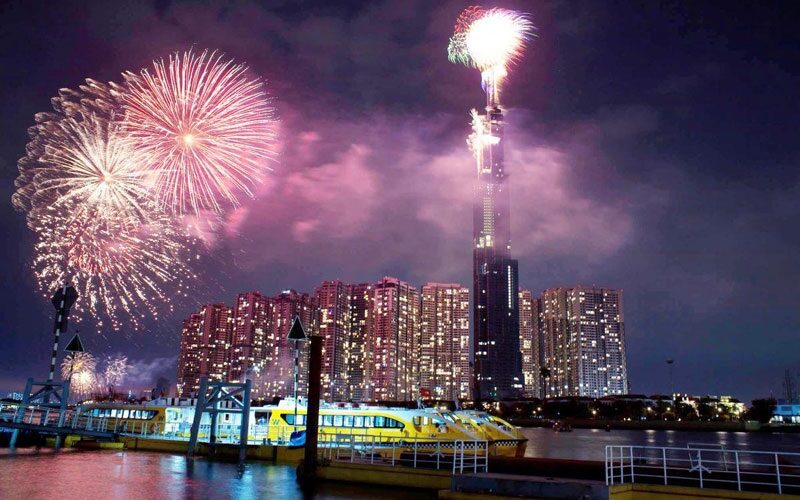
Fireworks in Ho Chi Minh City
Livelier than the capital Hanoi, Ho Chi Minh City is an interesting destination for tourists thanks to its very interesting and dynamic nightlife. On the eve of the Lunar New Year, you can choose to spend New Year’s Eve in the bars or watch the fireworks in the streets with the locals.
Participating in the Nguyen Hue Flower Festival and the Tao Dan Flower Festival is another way to celebrate Tet in a very local atmosphere. The streets will be decorated with flowers, mainly red and yellow – two colors representing the Lunar New Year – folk music, games, and food in a warm atmosphere.
Vietnamese New Year 2024, or Tet Nguyen Dan is the most important festival of the year and the one that most marks Vietnamese cultural identity. Although this occasion is not highly recommended for a Vietnam tour, if you still want to enjoy the atmosphere of Tet in Vietnam, please do not hesitate to contact us for more information.
